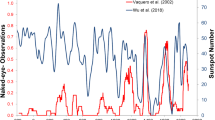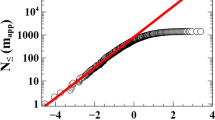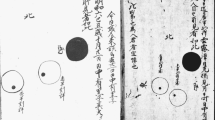Abstract
A long-term variability of visual sporadic meteor hourly rates is studied in the period between 1984 and 2006. The present analysis involves four particular periods of visual sporadic meteor activity in January, March, July and September over two solar cycles, and the results reveal that the observed visual sporadic meteor rates vary periodically in the course of the solar cycle. It is found that the highest sporadic meteor rates are observed in the years near solar activity maxima, and their variability directly correlates with solar activity expressed by International sunspot numbers.
Similar content being viewed by others
1 Introduction
A possible link between the meteor rate variability and the solar cycle has been first considered by (Bumba 1949), who studied meteor, fireball and meteorite fall activity in the years 1844–1943 and concluded that the highest frequency of meteor-related phenomena occurs in the years of minimum of solar activity. However, his conclusions were based on relatively small meteor numbers, which were collected by various observing techniques. The interest on the topic has been brought back to attention after the anomalous increase of radar meteor counts reported worldwide in 1963. (Hughes 1974) and (Lindblad 1976) analyzed available records at that time and found that the frequency of radar meteor echoes varies inversely with the solar activity. Moreover, the magnitude of this variation was found to be considerable, with almost twofold increase of radar echoes at the time of solar activity minimum (Lindblad 2003). A physical model, which qualitatively explained the observed variability of radar meteor rates, has been proposed by (Ellyett and Kennewell 1980). The model explained the observed variability of radar meteor rates as due to atmospheric effects, since the terrestrial atmosphere experiences periodic density variations (compressions and expansions) responding to changes in the flux of solar X-ray and extreme ultraviolet radiation in the course of 11-year solar cycle. Indeed, the most severe disturbances of the terrestrial environment are traced in the high atmosphere, and ionosphere in particular, where temperature and number density of charged particles at 150–800 km height varies considerably during the solar activity cycle (Lean 1997). However, at meteoroid ablation heights (80–120 km), the atmospheric density changes are still appreciable; for instance, during the solar activity minimum, meteoroids encounter a steeper atmospheric density gradient, which results in ablation of a meteoroid of a given size over a shorter path length, and vice versa.
However, the aforementioned studies did not strictly distinguish between the sporadic and shower meteors; the numbers of the latter being strongly influenced by local encounter conditions, which may vary significantly from year to year on their own course. It is important to note, that the most recent analysis of truly sporadic meteor observations is much in contrast with the previous results, and therefore raises new issues, whose origins still have to be unveiled. In particular, (Pecina and Simek 1999) showed that the background sporadic meteor radar rates recorded in December during the Geminid observing campaigns vary in phase with solar activity. Strong correlations for the January and August sporadic meteor rates (Simek and Pecina 2002) confirmed this new finding, yielding the correlation coefficient between the sunspot numbers and radar meteor rates as high as 0.7. More recently, a very similar (although somewhat weaker in terms of the correlation coefficient) relationship has been discovered also for visual sporadic meteor rates, recorded in September (Dubietis and Arlt 2007).
In this paper we extend the analysis of variability of the observed visual sporadic meteor rates by choosing four representative periods of the sporadic meteor activity in January, March, July and September in the years 1984–2006, covering the period of two solar cycles.
2 Observational Data
The radiants of sporadic meteors are not randomly distributed over the celestial sphere, but rather clustered around particular areas in the sky. Radar studies of sporadic meteors revealed compact radiant groups around the helion and antihelion points, more diffuse radiant concentration in the apex and antiapex directions, and broad southern and northern toroidal sources (Campbell-Brown and Jones 2006; Campbell-Brown 2008). The detected sporadic meteor rates exhibit considerable diurnal and seasonal variations as a result of variable geometrical encounter conditions—Earth‘s orbital motion, rotation and axis tilt. This also causes latitudinal variations of the detected sporadic meteor rates (Szasz et al. 2004).
The Visual Meteor Data Base (VMDB) maintained by the International Meteor Organization (IMO) comprises the most comprehensive dataset of standardized visual observations gathered by the joint efforts of amateur meteor observers around the globe. The VMDB provides year-round observational records for shower and sporadic meteor activity since 1984. The majority of the sporadic meteors, which could be detected by visual means, come from antihelion, apex and toroidal sources, having radiants between these broad concentration points. In order to minimize the effect of meteor rate dependence on the radiant zenithal distance, as well as to reduce the other possible biases, we have composed our sporadic meteor dataset using following considerations. The sporadic meteors from the antihelion source were subtracted form the dataset, since they are clearly indicated in the VMDB as belonging to distinguished ecliptical meteor showers active throughout the year. The dependence of observed meteor numbers on the zenithal radiant distance (that mostly refers to the apex source, whose radiant rises by late evening) was minimized by selecting the observations carried out only before the local midnight. In order to avoid differences in sporadic meteor numbers seen from the northern and southern hemispheres, we restricted ourselves to observations from the northern hemisphere only, where geography of the observing locations ranges from 30° to 60° northern latitude, whereas the bulk of observational data is collected from compact range of locations distributed between 45° and 55° northern latitude. For present analysis we have selected four periods of interest, namely 05 January–05 February, 10 March–10 April, 10–25 July and 10–30 September, which are free from any major shower activity. The length of each particular period has been chosen with account for a number of available records, ensuring that it provides continuous and reliable data coverage from year to year. The sporadic meteor dataset therefore amounts to a total of 96867 sporadic meteors observed in the years from 1984 to 2006.
3 Statistical Data Analysis
Evaluation of the meteor shower activity from visual observations is carried out using a standard procedure, which involves the calculation of the zenithal hourly rate, ZHR, that is the hourly rate of meteors seen by a single observer under optimum sky conditions, which are quantitatively described by a stellar limiting magnitude of Lm =+6.5, and with the radiant being situated in the local zenith (Jenniskens 1994). Since sporadic meteors radiate from very diffuse areas, the dependence of the hourly rate on the average zenithal radiant distance is assumed to be weak, and therefore the hourly rate of the sporadic meteors HRspo is defined as
where n spo is the number of sporadic meteors observed in a time interval T eff, Lm is the stellar limiting magnitude, F is the correction for possible field obstructions (cloud coverage, etc.), r is the population index of the sporadic meteor magnitude distribution, and c p is the individual perception correction. Since the individual perception of the particular observer is not known in advance (in practice, it is usually deduced from the observed sporadic meteor rates and thus could not be used in the present analysis), the problem of the individual perception was solved by averaging the observations of a variety of observers within the period of interest:
where
is the total correction factor for the limiting magnitude and field obstruction factor. The index i refers to the individual observing periods. In the present analysis, individual periods contributing to a single average HRspo value varied from 10 to 200, being reported by 10 individual observers at least, and more than 50 observers at the best. These numbers are sufficient for obtaining an average perception c p close to 1. The statistical error in meteor counts \({\Updelta}\hbox{HR}_{\rm spo}\) was estimated as
according to Poissonian statistics. The major contribution to the sporadic meteor activity comes from faint meteors, as might be expected from the low magnitude population index of r = 2.95 (Rendtel 2006). More precisely, the population index exhibits slight seasonal variations, and the particular values of r used in our analysis are listed in Table 1. In the calculations of HRspo we make use only of the observations carried out under good observing conditions (Lm ≥ 5.5), since the expected rate variations are most sensitive to increased or decreased detections of faint meteors.
The long-term activity profiles of visual sporadic meteor rates observed in January, March, July and September are plotted in Fig. 1, outlining several important features. First of all, the four investigated time periods are characterized by rather different sporadic meteor activity levels, with the lowest average rates HRspo = 7.7 and HRspo = 9.1 in March and January, and with the highest rates of HRspo = 10.9 and HRspo = 11.6 in July and September, respectively. This result is fairly consistent with recently published data, outlining the annual variations of radar sporadic meteor rates from the northern apex and northern toroidal sources (Campbell-Brown and Jones 2006) and visual sporadic meteor rates from the northern apex source (Rendtel 2006). Secondly, beside a well-established seasonal variation, our data suggests that visual sporadic meteor rates vary in the order of about ±15% around their average values on a much larger time scale. The amplitude of this variation well exceeds the error bars of the individual data points in all four plots, and therefore could be regarded as a real change in detected meteor numbers. Large-period variations are clearly present in all four activity plots and seem to be far from random, suggesting the lowest sporadic meteor hourly rates in 1985, 1995 and 2006, and the highest ones in 1991 and 2002. This raw observation implies that visual sporadic meteor rates follow to some extent the level of solar activity.
In order to check this issue in a more precise manner, we have performed a statistical analysis, which involved the calculation of the cross-correlation function cc(l) between HRspo and the International sunspot numbers, R i :
where t is time (years), l is the time lag, the overline operators denote time averages, σ(HRspo) and σ(R i ) are the variances of time series of sporadic meteor rates and International sunspot numbers (formerly known as Zurich or Wolf numbers), respectively. The variability of the sunspot numbers in the period of interest is illustrated in Fig. 2.
Solar activity, expressed in monthly averages of the International sunspot numbers R i , in the years 1984–2006; data from http://sidc.oma.be/sunspot-data/
The calculated cross-correlation functions for all four investigated periods are plotted in Fig. 3 and reveal almost identical features. In general, the cross-correlation signal is clean, with well-defined periodic minima and maxima. More specifically, all four cross-correlation functions peak almost at zero time lag, whereas their minima are shifted by 4–6 years. The slight exception is the cross-correlation function for January, where the maximum cross-correlation coefficient coincides with the time lag of ∼11 years. We attribute this artifact to marked differences of January sunspot numbers recorded in the years 1989–1991 and 2000–2002, respectively. Indeed, this specific feature is present only in January sunspot data, where sunspot numbers for successive solar maxima differ by a factor ∼1.5. The results of Fig. 3 provide a clear signature that visual sporadic meteor rates vary exactly in phase with solar activity, with the highest observed hourly rates occurring in the years of maximum, while the lowest, in the years of minimum sunspot numbers. This finding is very much in line with the results of (Simek and Pecina 2002) obtained for radar sporadic meteor rates. Here we note that the correlation between visual sporadic meteor rates and sunspot numbers (correlation coefficient of ∼0.3) is weaker as compared to that obtained for radar sporadic meteors (correlation coefficient of ∼0.7), and we attribute this difference to the somewhat different detected mass range (m = 10−4 g for the faintest detectable visual meteors of magnitude m v = 6.5 and and m = 10−7 g for the faintest meteors detected by radar), since indeed, the most sensitive modifications of meteor detectability function should apply for the faintest meteors only. The other uncontrollable factors of visual observation may include varying number of observers, viewing direction, and perhaps some influence of diurnal rate variations, which were not completely ruled out. It has to be noted that for July and September data, there is a slight shift of maximum rates by 1–2 years with respect to the solar activity maximum, which is again in agreement with the results of (Simek and Pecina 2002), where authors explained this shift as due to largest solar flares and coronal mass ejections occurring exactly 1–2 years after the sunspot maximum. The results of the present study are summarized in Table 1.
4 Conclusions
We have demonstrated that long-term variations of visual sporadic meteor rates directly correlate with solar activity, with highest sporadic meteor rates occurring at the solar activity maximum and the lowest rates at the solar minimum. A distinct covariance with a correlation coefficient of ∼0.3 is found between variations of the sporadic meteor rates recorded in January, March, July and September and the International sunspot numbers, and suggests that the disclosed relationship could be regarded as due to a real change in detected meteor numbers. Our findings are much in support to the recent results concerning the correlation of radar meteor rates and solar activity (Pecina and Simek 1999; Simek and Pecina 2002). Since visual and radar meteors represent different meteoroid mass ranges, the discovered connections justify the universality of origins of their variability, whose detailed physical causes have still to be unveiled.
And finally, it is worth noting, that our findings, however, do not reflect real variations of the sporadic meteor influx, which is estimated to be of the order of 20 000 tons per year (including micrometeors as well) (Ceplecha et al. 1998), but rather represent a modulation of the meteor detectability function, which results in apparent variations of meteor rates. The only real variation of the sporadic meteor rates is foreseen on a time-scale of centuries being due to the decay of short-period comets and compact meteoroid streams (Hughes 1990).
References
V. Bumba, Influence de l‘activité solaire sur le nombre des observations de météores, de traînées météoriques et de chutes météoritiques. Bull. Astron. Inst. Czechosl. 1, 93 (1949)
M.D. Campbell-Brown, J. Jones, Annual variation of sporadic radar meteor rates. Mon. Not. R. Astron. Soc. 367, 709 (2006)
M.D. Campbell-Brown, Directional variation of sporadic meteor activity and velocity. Earth, Moon, Planets 102, 79 (2008)
Z. Ceplecha, J. Borovicka, W.G. Elford, D.O. ReVelle, R.L. Hawkes, V. Porubcan, M. Simek, Meteor phenomena and bodies. Space Sci. Rev. 84, 327 (1998)
A. Dubietis, R. Arlt, Long-term variability of visual sporadic meteor rates. WGN. J. Int. Meteor. Org. 35, 134 (2007)
C.D. Ellyett, J.A. Kennewell, Radar meteor rates and atmospheric density changes. Nature 287, 521 (1980)
D.W. Hughes, Meteor rates, volcanoes and solar cycle. Nature 252, 191 (1974)
D.W. Hughes, The mass distribution of comets and meteoroid streams and the shower/sporadic ratio in the incident visual meteoroid flux. Mon. Not. R. Astron. Soc. 245, 198 (1990)
P. Jenniskens, Meteor stream activity. I. The annual streams. Astron. Astrophys. 287, 990 (1994)
J. Lean, The Sun‘s variable radiation and its relevance to Earth. Annu. Rev. Astron. Astrophys. 35, 33 (1997)
B.A. Lindblad, Meteor radar rates and the solar cycle. Nature 259, 99 (1976)
B.A. Lindblad, Solar control of meteor radar rates. Technical Report ESA SP-535, 755 (2003)
P. Pecina, M. Simek, Analysis of the Geminid meteor stream, 1958–1997, from radar observations. Astron. Astrophys. 344, 991 (1999)
J. Rendtel, Visual sporadic meteor rates. WGN. J. Int. Meteor. Org. 34, 71 (2006)
M. Simek, P. Pecina, Radar sporadic meteor rates and solar activity. Earth, Moon, Planets 88, 115 (2002)
C. Szasz, J. Kero, A. Pellinen-Wannberg, J.D. Mathews, N.J. Mitchell, W. Singer, Latitudinal variations of diurnal meteor rates. Earth, Moon, Planets 95, 101 (2004)
Author information
Authors and Affiliations
Corresponding author
Rights and permissions
About this article
Cite this article
Dubietis, A., Arlt, R. Periodic Variability of Visual Sporadic Meteor Rates. Earth Moon Planets 106, 105–111 (2010). https://doi.org/10.1007/s11038-010-9351-6
Received:
Accepted:
Published:
Issue Date:
DOI: https://doi.org/10.1007/s11038-010-9351-6







